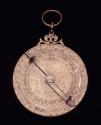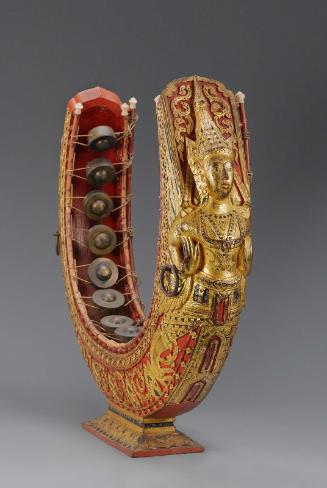Planispheric astrolabe
dated 1375
Object PlaceBarcelona, Spain
Medium/TechniqueGilded brass
Dimensions10.9 x 16.2 cm (4 5/16 x 6 3/8 in.)
Credit LineGift of Mrs. A. C. Baldwin
Accession number88.654
On View
On viewClassificationsInstruments
Collections
The astrolabe is a two-dimensional model of the universe, used to tell time by measuring the altitudes of the sun or a selected fixed star at a given moment. Originating with the Greeks (its name comes from the ancient Greek astrolobos, “star-taker”) and refined by Muslim astronomers in the Middle Ages, it was one of the most important and versatile early scientific instruments. Beyond time-telling, its uses ranged from navigation to charting horoscopes, and it served as inspiration for later astronomical clocks like the one in this case. Signed and dated, this astrolabe is one of the earliest known European examples.
InscriptionsAround the edge is the inscription: " + Hoc astralabium: fuit factum : et cum armillis verifficatum Barghionone : anno Xri 1375. per Petrum Raimodi de domo regis Aragonum : lati Barghinone : 41 longi 39"ProvenanceBefore 1876, A. C. Baldwin
early 20th century
early 20th century
early 20th century
early 20th century
early 20th century
early 20th century
late 16th or early 17th century
18th century









